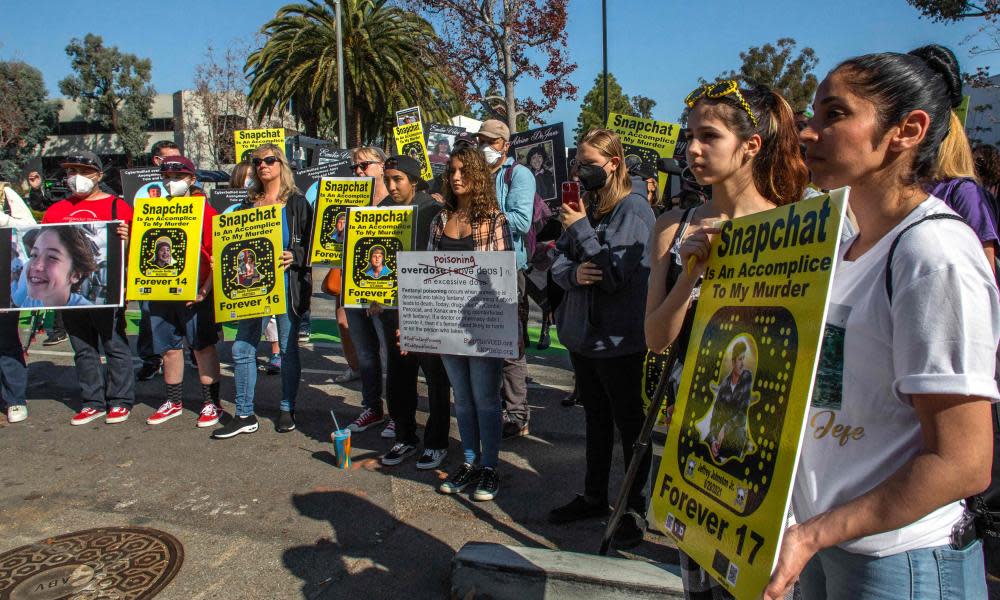US teen overdose deaths double in three years amid fentanyl crisis

Drug overdose deaths among high school-aged US teens have more than doubled since 2019, driven by a rise in the deadly opioid fentanyl, a new study has found.
Researchers at the University of California, Los Angeles, who analyzed mortality rates among 14- to 18-year-olds over the past decade, found that while drug use among this age group is actually falling, fatalities are on the rise, jumping from 492 in 2019 to 954 in 2020, then climbing to 1,146 in 2021.
Related: ‘It’s devastating’: how fentanyl is unfolding as one of America’s greatest tragedies
Researchers attribute this to a flood of counterfeit pills, which look exactly like real oxycodone or Xanax tablets, but actually contain fentanyl, a synthetic opioid so potent that one counterfeit pill can prove fatal. Vast quantities of these fake pills are being smuggled into the country and are circulating in the illicit drug market, meaning that teens often ingest the deadly drug unknowingly.
“We’re seeing really young kids start to die, because the illicit drug supply has become extremely toxic,” said Joseph Friedman, who led the study, published on 12 April in Jama.
The study found that the rates of drug deaths are highest among Indigenous and Hispanic teens, but that young people of all races are affected.
“It’s scary stuff,” said Friedman, who said even though reported drug use among teens was at all-time lows, the deaths represented the major first overdose spike seen in adolescents since tracking began. “Teens are continuing to experiment with pills; the pills are just getting much more deadly.”
A recent study by researchers at the University of California, San Francisco, found that more than 2m fentanyl-filled fake pills were seized by law enforcement agencies in the last quarter of 2021 alone – an indication of how common they have become in the nation’s illicit drug supply.
The UCLA study cited survey data showing that the number of 10th graders reporting having used drugs in the past year held steady at about 30% between 2010 and 2020 and then dropped to only 18% during 2021, as the pandemic stretched on.
“A really important fact here is that more kids are not doing drugs,” said Morgan Godvin, a Portland, Oregon-based drug addiction researcher and co-author of the study. “The drugs they are doing are just incredibly more lethal.”
The study comes at a time when the number of overdose deaths in the US has exploded to more than 100,000 a year due to the huge amounts of fentanyl and other synthetic opioids saturating the country’s drug supply. Fentanyl is as much as 100 times more potent than morphine.
“These counterfeit pills are spreading across the nation,” said Friedman, “and teens may not realize they are dangerous.”
While many adult users may know the pills they are buying on street markets actually contain fentanyl, youth most likely believe they are getting genuine pharmaceuticals, the researchers said.
“Kids think that pills are very safe,” said Godvin. “Because, while they may not might not have been prescribed to them, they were supposedly prescribed to someone. And [young people] believe the purity does not vary.”
In reality, though, the opioid dosages in counterfeit pills can vary dramatically. The Drug Enforcement Administration estimates that four in 10 seized pills contain potentially lethal doses.
The authors called for more drug education in schools, giving kids realistic information about how to protect themselves from fentanyl.
“High school might be too late,” said Friedman. “We need to include information about drugs on the street in school even earlier.”
The researchers said youth should also be given education about and access to Narcan, the overdose reversal drug, which can revive someone who has overdosed, and fentanyl test strips, which can detect counterfeit pills.
Researchers and youth advocacy groups say teens are often easily able to obtain the pills from friends or from local dealers, who offer them on social media apps like Snapchat or Instagram and sometimes deliver them straight to teenagers’ homes.
Guardian interviews with families that lost teenagers to accidental overdoses from fentanyl pills show that it can happen to anyone.
In February 2021, Sammy Berman Chapman, a 16-year-old straight-A student and the son of the television therapist Laura Berman, died in his bedroom in Los Angeles after taking what he thought was a single Xanax. In Arizona in 2020, Zach Plunk, a 17-year-old star high school running back, died after taking one tablet, labelled to look just like a pharmaceutical “M30” oxycodone pill. In both cases, the tablets, bought over social media, turned out to be deadly doses of fentanyl.
Snapchat recently announced increased measures to combat drug dealing on the platform, while Instagram has said the company works to remove such content.
“It’s just so sickening,” said Plunk’s mother, Wendy Plunk, who says there is still not enough being done to stop kids from getting the fake pills over social media sites and to warn them about the danger. “We need to get the word out.”

